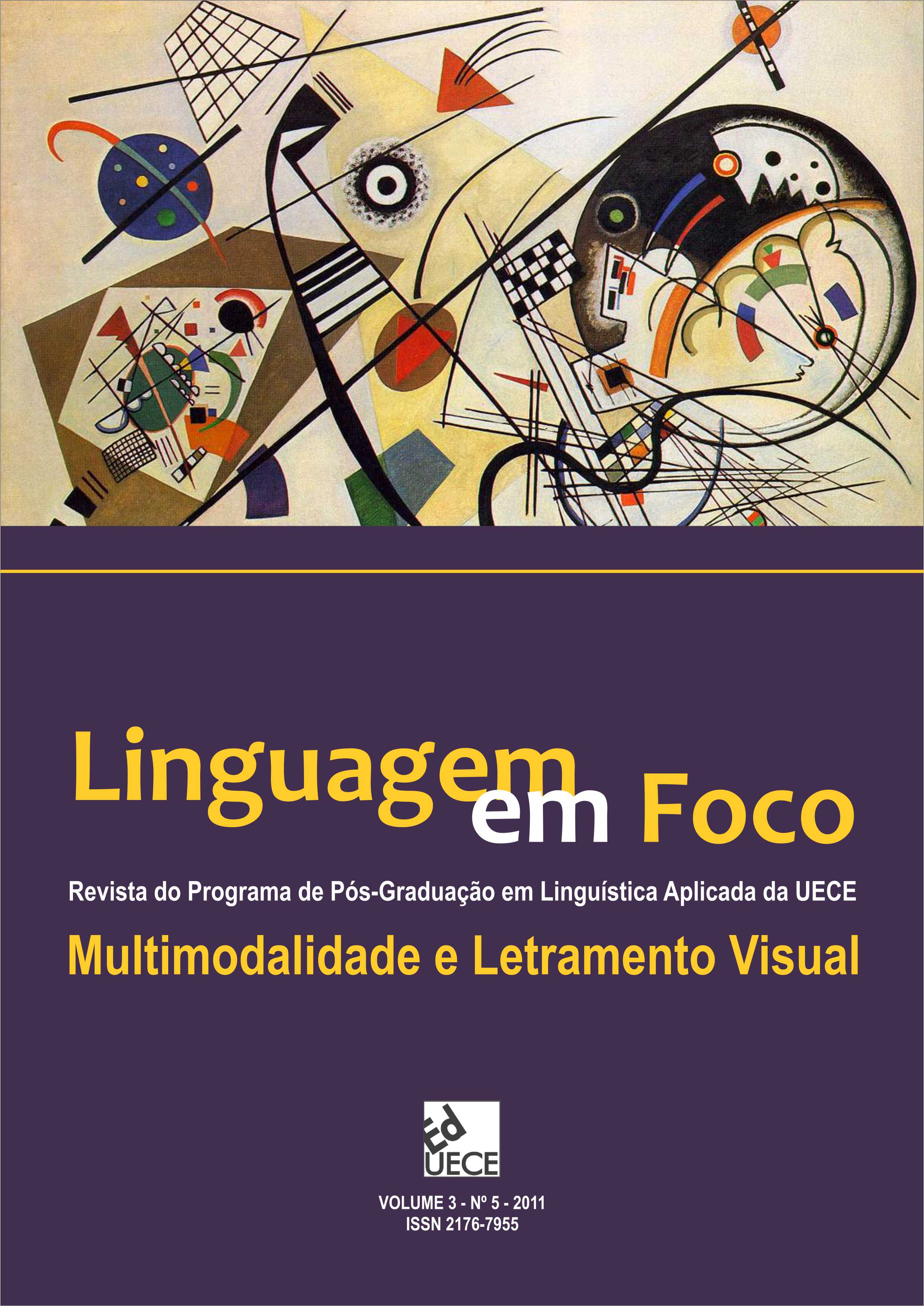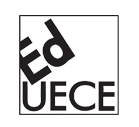VISUALIZAÇÃO: A QUINTA HABILIDADE LINGUÍSTICA NO ENSINO E APRENDIZAGEM DE INGLÊS COMO LÍNGUA ESTRANGEIRA
Palabras clave:
Letramento crítico visual, Material crítico em sala de aula, Ensino de inglês, VideoclipResumen
Em nossa sociedade, cheia de imagens, representações visuais e experiências visuais de todos os tipos, há, sim, paradoxalmente, ainda um grau significativo de analfabetismo visual. Apesar da importância de desenvolver competências visuais específicas, “letramento visual” ainda não é uma prioridade nos curriculos escolares (SPALTER e DAM, 2008). Este artigo tem como objetivos (1) enfatizar a importância de integrar o letramento visual crítico como a quinta habilidade línguistisca em sala de aula de inglês com base nas novas normas da Associação Internacional de Leitura e do Conselho Nacional de Professores de Inglês Americano (IRA / NCTE, 1996), e (2) apresentar uma sugestão de atividade visual, usando o videoclip da cantora Jessie J chamado Price Tag, como uma atividade crítica pedagógica.
Descargas
Citas
AUSTIN, J. L. How to do things with words. Cambridge: Harvard University Press, 1962.
BEARE, K. YouTube in the classroom! 2008. Disponível em: <http://esl.about.com/od/listeninglessonplans/a/youtube.htm>. Acesso em: 02 mar. 2012.
BEARNE, E. Rethinking literacy: Communication, representation and text. Reading Literacy and Language, 37(3), 98-103, 2003.
BURNS, A.; S HOOD. Teachers’ voices 3: Teaching critical literacy. Sydney: NCELTR,1998.
CADIERO-KAPLAN, K. Literacy ideologies: Critically engaging the language arts curriculum. Language Arts.79, 372–381, 2002.
CERVETTI, G., et al. A tale of differences: Comparing the traditions, perspectives, and educational goals of critical reading and critical literacy. Reading Online, 4(9). Disponivel em: http://
wwwreadingonline.org./ articles/art_index.asp?HREF=/articles/ cervetti.index.html>. Acesso em: 02 mar.2012.
CONIAM, D. The use of audio or video comprehension as an assessment instrument in the certification of English language teachers: A case study. System, 29, 2001, 1-14.
DALLOW, P. The visual complex: Mapping some interdisciplinary dimensions of visual literacy. In J. Elkins (Ed.),Visual Literacy . New York: Routledge, p.91-103, 2006.
DURANTI, A. The audience as co-author: An introduction. Text 6; 1986, 239-247.
FEHLMAN, R. Viewing film and television as whole language instruction. The English Journal, 85 (2), 43-50, 1996.
FREIRE, P. Pedagogia da autonomia: saberes necessários à prática educativa. 35 ed. São Paulo: Paz e Terra,1970.
FREIRE, P. Pedagogia do oprimido. 24ª ed. Rio de Janeiro: Paz e Terra, 2003.
HINKEL, E. Current perspectives on teaching the four skills. TESOL Quarterly 40 (1), 109-131, 2006.
HODGE, R.; KRESS, G. Social semiotics. Oxford, England: Polity Press, 1988.
JESSIE J. Music video Price Tag featuring B.o.B. (C) 2010. Standard YouTube License. Disponivel em<http://www.youtube.com/watch?v=qMxX-QOV9tI>. Acesso em: 18 mar.2012.
JEWITT, C. The move from page to screen: the multimodal reshaping of school English. Visual Communication, 1(2), 171-195, 2002.
KELLNER, D. New technologies/new literacies: Reconstructing Education for the New Millennium. Teaching Education 11; 245-65, 2002.
KRESS, G.,;VAN LEEUWEN, T. Reading images: The grammar of visual design. London, England: Routledge, 1996.
KRESS, G. ; VAN LEEUWEN, T. Multimodal discourse. London: Routledge, 2001.
KRESS, G. English for an era of instability: Aesthetics, ethics, creativity and design. English in Australia,134, 2002,15-23.
KRESS, G. Literacy in the new media age. London: Routledge, 2003.
LUKE, A. Critical literacy in Australia: A matter of context and standpoint. Journal of Adolescent & Adult Literacy, 43, 245-65, 2000.
MAYER, R. E. Multimedia Learning. In B. H. Ross (Ed.), The Psychology of Learning and Motivation Vol. 41, San Diego, CA: Academic Press, 2002, pp. 85-139.
MESSARIS, P.; MORIARTY, S. Visual literacy theory. In K. Smith (Ed.), Handbook of visual communication:Theory, methods, and media. Mahwah, N.J.: L. Erlbaum, 2005, pp. 479-502.
MCKINNON.M, Teaching technologies: Teaching English using video.2011. Disponível em: <http://www.onestopenglish.com/support/methodology/teaching-technologies/teaching-technologiesteaching-english-using-video/146527>. Acessado em: 23 fev, 2012.
NEWFIELD, D. From visual literacy to critical visual literacy: An analysis of educational materials. 2011. Disponivel em: <http://education.waikato.ac.nz/research/files/etpc/files/
2011v10n1art5.pdf.> Acesso em 10 mar.2012.
NEW LONDON GROUP. A pedagogy of multiliteracies: Designing social futures. Harvard Educational Review, 66(1), 1999.
OXFORD, R. Integrated skills in the ESL/EFL Classroom. In: ESL Magazine 6:1, 2001.
ROBERT-MILLER, T. Understanding misunderstandings: How to do a rhetorica analysis. Department of Rhetoric and Writing, The University of Texas at Austin Design. 2008. Disponível
em: < http://www.drw.utexas.edu/roberts-miller/handouts/rhetorical-analysis>. Acesso em: 02 fev. 2011.
SHANAHAN. T. Relations among oral language, reading, and writing development. In C. MacArthur, S. Graham, and J. Fitzgerald (eds.) Handbook of Writing Research. New York: Guilford Press, 2006.
SPALTER, A.; VAN DAM, A. Digital visual literacy. Theory into Practice, 48, 2008.
SOSA, T. Visual literacy: The missing piece of your technology integration course. TechTrends: Linking Research and Practice to Improve Learning,53 (2), 55-58, 2009.
SELBER, S. Multiliteracies for a digital age. Carbondale, Southern Illinois University Press, 2004.
SWAFFAR, J.; VLATTEN, A. A Sequential model for video viewing in the foreign language curriculum. The Modern Language Journal, 81(2), 175-188, 1997.
TING HUNG HSIU. Learners’ perceived value of video as mediation in foreign language learning. Journal of Educational Multimedia and Hypermedia, vol. 18, n. 2, 171-190, 2009.
UNSWORTH, L.; WHEELER, J. Re-valuing the role of images in reviewing picture books. Reading literacy and language, 36(2), 68-74, 2002.
WALSH, M. The textual shift: examining the reading process with print, visual and multimodal texts. Australian Journal of Language and Literacy, 29(1), 24-37, 2006.
WILEMAN, M. S. Visual communicating. New Jersey: Educational Technology Publications,1993.
YANG et al. Integrating video-capture virtual reality technology into a physically interactive learning environment for English learning. Computers & Education 55 (1), 1346-1356, 2010.
Descargas
Publicado
Cómo citar
Número
Sección
Licencia
Derechos de autor 2019 Giselda dos Santos Costa

Esta obra está bajo una licencia internacional Creative Commons Atribución 4.0.
Os autores que publicam na Linguagem em Foco concordam com os seguintes termos:
- Os autores mantêm os direitos autorais e concedem à revista o direito de primeira publicação. Os artigos estão simultaneamente licenciados sob a Creative Commons Attribution License que permite a partilha do trabalho com reconhecimento da sua autoria e da publicação inicial nesta revista.
- Os conceitos emitidos em artigos assinados são de absoluta e exclusiva responsabilidade de seus autores. Para tanto, solicitamos uma Declaração de Direito Autoral, que deve ser submetido junto ao manuscrito como Documento Suplementar.
- Os autores têm autorização para disponibilizar a versão do texto publicada na Linguagem em Foco em repositórios institucionais ou outras plataformas de distribuição de trabalhos acadêmicos (ex. ResearchGate, Academia.edu).

























